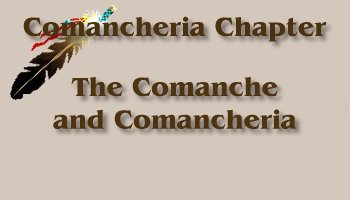|
History Prior to 1705, the Comanche were mountain people living in the current states of Wyoming and Montana. Little is known of their history at that time. Having no written language, their history has been preserved only in the memories of their people. Even today, it is told that long ago their ancestors were part of a larger group know as the Shoshone or the Snake People. The many different peoples of the Great Plains devised a sign language in order to communicate with each other. In these hand gestures, the people who became the Comanche were referred to with a wiggling hand gesture that represented the movement of a snake. For most of the 18th and 19th centuries, the Comanche dominated over 250,000 square miles of the southern Plains. It is possibly the largest area of land claimed and defended by any Indian Nation. Comancheria's boundaries were marked by the Arkansas River in southern Colorado and extended to the Rio Grande in the south portion of Texas. Sections of Kansas, New Mexico, and Oklahoma were also part of Comancheria. The Kiowa shared this land after peace was made with the Comanche in the early 1800s. Sometimes the two nations camped together in Comancheria. To enter Comancheria without being invited was an act of war. The Comanche fought fiercely and successfully to defend Comancheria and the Comanche way of life. In doing so, they proved their superiority in warfare against all people. The only serious threat to Comanche control came from the Apache, who took over Comancheria for a short time before the Comanche ran them from the Plains in the early 1700s. In the 18th century, the French and the Spanish sought Comanche friendship, but French and Spanish penetration of Comancheria was allowed with grudging permission from the Comanche. Later, the Mexicans and Texans made a futile attempt to conquer the Comanche and settle on the southern Plains. For a decade after the other Indian nations had submitted to the United States government, the Comanche lived free in Comancheria. Comancheria remained a barrier to settlement by outsiders until late in the 19th century. Control by the Americans required a long and bloody struggle.
Wars, Raids, and Hunting Comanche warriors, through much practice, could sweep down on an enemy by hanging underneath a horse, providing shelter from attack. A war shield, sometimes draped on the opposite side of the mount, protected horse and rider. From underneath the neck of a horse or over the horses back, a warrior could fire arrows at a very rapid rate. Most wars fought with the Comanche were over the theft of Comanche horses or the killing of a loved one. Comanche were known to raid deep into Mexico, returning horses and many goods. They were probably the wealthiest Indian Nation; most of their wealth was in horses. Many Comanche warriors would risk their lives to save their horses. Blanco and Palo Duro Canyons are both in the land of Comancheria. (Palo Duro Canyon is the second largest canyon on the continent and is often called the "Grand Canyon of Texas.") In these canyons, the different bands of Comanche would camp and hunt during the winter. The canyons offered peace and security from their enemies on the Llano Estacado, where the winds can be cruel and the winters are deathly cold. Flint for arrows was gathered from Monument Springs, New Mexico, in the far west of the Llano Estacado. Closer to the canyons was the Alibates, a quarry north of Amarillo, Texas. Summer camp was often set up east of the Alibates, in a wooded area where the winds blew cool across the plains.
Foodstuffs and Medicines Millions of buffalo roamed the land. Deer and antelope were plentiful. Following a successful hunt, the people gave thanks to the Father for the bounty. They would sing and dance, rejoicing in the great fruits the land had provided for the people. Fruit, such as chokecherries and plums, and pecans were plentiful. Pemmican, pounded into a form of jerky, was made from fruits mixed with buffalo meat. Wild potato, known as yampa, was used to make bread. The wild potato was also used in stews. Many of Comancheria's herbs and cactus had medicinal value. Prickly pear leaves were often used to make a good bandage. It was soothing to deep cuts and promoted healing of the skin. Juice from the cactus would help inhibit infection in a wound. Mesquite beans were sometimes used for problems in the digestive tract. Certain roots and herbs were used together to promote healing many illnesses and injuries. Ground rattlesnake rattles were used in hard deliveries to promote the birthing process. The Final Generation in Comancheria In 1835, 9-year-old Cynthia Ann Parker was captured from Fort Parker in Limestone County, Texas. She survived to become the wife of the great Comanche chief, Peta Nocona. Their firstborn son, Quanah, became the last Comanche chief before surrender to the reservation. Chief Quanah Parker, while maintaining his Comanche customs, adapted well to the white man's world. He was well-known as an effective negotiator and orator in his years on the reservation. He, his mother, and his sister are buried at Ft. Sill, Oklahoma.
Conclusion The Comanche adapted to the land in this place called the Great American Desert. Though there was little water and food seemed scarce, the people thrived. The beauty of the canyons and the vastness of the Llano Estacado, provided the Comanche with everything they needed to survive. While white man called Comancheria wild and untamed, the Comanche called it home.
Artistic Concept and Photography by Jeri Pundt, Comancheria VIS Chairman, 2000-2002 Feather
graphics © copyright, Silverhawk's
Creations |

